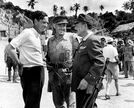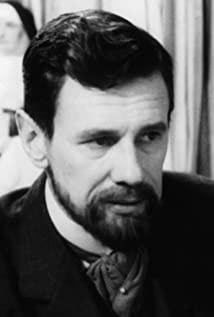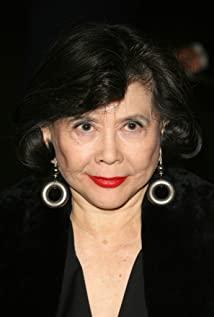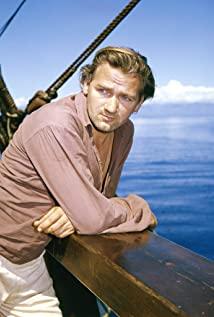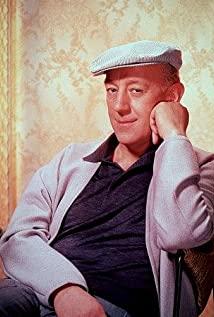The British military doctor who looked on the sidelines clearly pointed out the main point of the film. Director Lean once said that his film "painfully but eloquently illustrates the absurdity and destructive power of war." This "absurdity" and "destruction" is not only manifested in poisoning living things and violent things, but also manifesting in the distortion of human nature and the deterioration of national character. Especially this latter point, in fact, it is exactly one of the main intentions of the film's creation, which reflects the director's deep cultural reflection on the British nation.
The rigidity and rigidity of the British are recognized by the world, and the soldiers have their bounden duty to obey orders. The protagonist of this film Nicholson is the image of British soldiers with the above-mentioned typical characteristics created by the director. He was "instructed to lay down his weapons", and he must execute this order to the full, so when someone proposed to flee, he firmly opposed it. Saito asked the British officers to perform hard labor. He did not hesitate to fight to death because it violated the Geneva Convention on the Treatment of Prisoners of War and was a matter of principle. Because he did not compromise, and Saito had to accept all his conditions in order to build the bridge on schedule. This was indeed a victory for him and maintained the dignity of the British soldiers. However, the extraordinary sense of honor of the British soldiers led him to the absurd: since prisoners of war had to repair the bridge, they could only build a bridge that could truly shine through the future generations and promote the prestige of the British under the command of the British officer. As for the purpose of building a bridge A real soldier shouldn’t bother--he faithfully executes orders from his superiors has become a fixed mindset. He never considers the purpose of giving orders. Even when he arrives in a prisoner-of-war camp, he never wants to make contingency in response to the situation; he will only blindly do To execute orders mechanically, he did not understand that the supreme purpose of war is to defeat the enemy, and all the enemy’s military efforts must be destroyed for this; he regarded the honor of British soldiers above all else, and he did not realize that only by defeating the enemy can there be real soldiers. honor. It was the absurdity of thought that led to the absurd behavior: at first he resolutely opposed the officer’s participation in the construction of the bridge, but later he not only led the officer’s labor, but also the wounded and sick. At the end of the film, he first discovered that someone tried to blow up the bridge. He led the enemy chief to the British bomber, and also fought with the latter to prevent him from bombing the bridge, even when the bomber revealed his identity and mission to him, he failed to wake up immediately. The director vividly shows through the artistic image of Colonel Nicholson that once the British stereotypes are taken to extremes under extraordinary conditions, what a tragedy may be!
The bridge was finally blown up by its builders, which can be said to be a magical touch of the director of the film (the bridge was not destroyed in the original work). First of all, this change further deepens the theme: Nicholson’s painstaking work, which he devoted all his efforts and months of hard work, suddenly vanished, and all his efforts became nothing, which further highlights the destructiveness and absurdity of war. sex. Secondly, such a change also has a deep consideration of moral dynamics in characterization: Nicholson's dedication to build bridges for the enemy is due to his nature, and it should be said that "good people make mistakes", showing the tragedy of the British national character. But if you let the bridge serve the enemy, Nicholson would actually be a crime, and he would not be a "good person." This artistic image would have serious moral defects, making it difficult for the audience at the time to accept it. This is obviously not in line with the 1960s. The general aesthetic principles of film creation before the decade. There needs to be an ethical reaction force to correct this moral imbalance. To untie the bell, the person who tied the bell must be tied. The ideal way to rescue the bell is to correct himself-Nicholson blew up the bridge himself. Finally, this change also makes the whole film more dramatic and enjoyable, and thus more attractive to the audience.
The film director ingeniously caused Nicholson to fall on the detonator and personally blow up the bridge that condensed his efforts. The reason for this is quite intriguing. There are three explanations here: 1. He finally realized something; 2. He. In confusion, due to lack of physical strength, he happened to fall on the detonator; 3. When he was about to dismantle the detonator, he fell down due to excessive blood loss and hit the firing pin. The three possibilities are all logical, let the audience conceive themselves. In the 1950s, this open ending was still new.
From a deeper point of view, the British colonel and the Japanese Daizu in this film are actually two symbolic codes, and their confrontation reflects the inevitable conflict between the two heterogeneous cultures of the East and the West. The editor and director compares their personalities, beliefs, and living habits. Both of them cherish an extraordinary sense of national pride, and their expressions themselves have distinct national characteristics. Although Nicholson was defeated, he was like an English gentleman. Saito is cruel in nature (in the eyes of the British, he is a barbarian), but in order to complete the task of building the bridge, he barely endures the arrogance of the British; once the bridge is completed, he will cut his belly for the honor of Japan. In order to contrast with the British stereotypes, the director introduced the American officer Hilles (in the original book he was British, with different personalities). Hills does not succumb to fate. He wants to run away, to have fun, and not want to fight; and once the battle starts, he goes through fire and water without hesitation—a typical American "hero". Through these layers of contrast, not only the characters' personalities are more distinctive, but the differences in national culture also become more apparent.
The film's drama structure is relaxed, ups and downs, and the rhythm is full of changes, showing Lean's excellent director skills. At the beginning of the film, Nicholson and Saito confronted each other, and the atmosphere suddenly became tense. Afterwards, the military doctors rounded the field, and the contradiction gradually eased, resulting in an ups and down. Then, with the two plot lines of the bridge building and the activities of the commando team members Parallel unfolding, new suspense gradually emerged; finally, the two lines crossed, and the conflict between the Japanese-British and Nicholson-Commando reached a climax. Several pairs of conflicts were suddenly resolved, and the three protagonists died almost simultaneously. ; The fast pace at this time is dazzling.
This film is David Lean, one of the representative works of Britain in the 1950s. In his early days, Lean was famous for making literary and dramatic movies (see "Meeting Hate Late" and "Blood and Tears of Lone Star"), and the films he produced have strong British national characteristics. Since the mid-1950s, Lean’s style has changed and he has embarked on an international road, specializing in "transoceanic movies" (that is, films that take into account the tastes of both British and American audiences on both sides of the Atlantic). The film is 50 The most famous "transoceanic film" in Britain in the 1940s. With the backing of strong American capital, Lean made the film a spectacular and magnificent film with the spirit of a war epic. The film has both a strong British taste and a colorful international color (the impact of Eastern and Western cultures, the contrast between British and American national characters, the exoticism of the tropical jungles of Southeast Asia, etc.); it is both ornamental and philosophical, which will make the audience after watching it. Endless aftertaste. All these have made this film a worldwide success. It is not only one of the best-selling films in the 1950s in the United Kingdom and the United States, but also won the most important film awards in the United Kingdom and the United States that year.
View more about The Bridge on the River Kwai reviews





